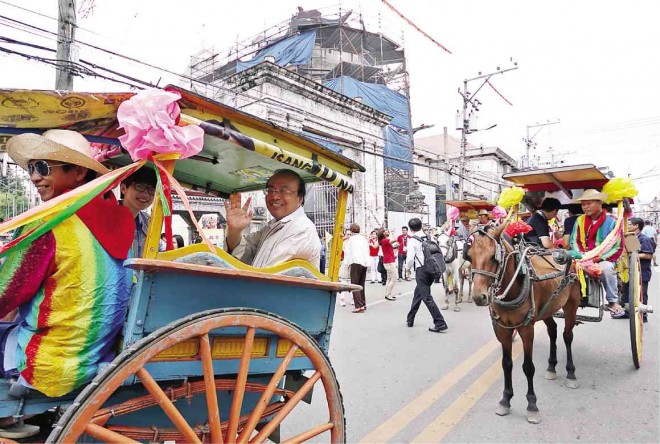
CHINESE Taipei delegates to the Asia-Pacific Economic Cooperation meetings in Cebu wave as they ride a “kalesa” (horse-driven carriages) after visiting Basilica Minore del Santo Niño. JUNJIE MENDOZA/CEBU DAILY NEWS
CEBU CITY—Delegates to the Asia-Pacific Economic Cooperation (Apec) 9th Transportation Ministerial Meeting (TMM9) got a glimpse of Cebu’s history and its economic development during 3-hour twin city tour on Saturday.
The Apec TMM9 delegates went on a tour around historical sites in Cebu City and Lapu-Lapu City.
The first stop of the tour, which started at Shangri-La’s Mactan Resort and Spa, was the Plaza Sugbo, located in front of the Cebu City Hall where a brief reenactment of the arrival of Portuguese explorer Ferdinand Magellan, accompanied by historian Antonio Pigafetta and Spanish soldiers, was done.
They turned over an image of the Santo Niño to Rajah Humabon who met them, together with a dancing Queen Juana who was sitting on a chair, carried by male attendants.
The delegates then went inside the kiosk where the Magellan’s Cross is placed.
Sinulog dance
Elderly women were also dancing the traditional Sinulog dance at the entrance of the Magellan’s Cross.
From the Magellan’s Cross, the group went inside the Basilica Minore del Santo Niño, one of the oldest churches in the Philippines, which was completed in the 17th century.
After the delegates left the Basilica complex, some delegates took rides on horse-driven carriages going to the nearby Fort San Pedro. Around 20 calesas were made available for the delegates.
Songs and dances, including a flamenco and the Sinulog dance, were presented. Spanish-inspired finger foods, including churros, croquettes, churvos with chocolate dip, tortilla Española or Spanish omelette, different types of ham and fruits, as well as drinks were served. At the Fort San Pedro, the delegates also took time to socialize with each other.
After the Fort San Pedro stop, the delegates were brought around Cebu City. The tour guides gave information on the life and culture of the city, a brief background on historic structures such as the provincial capitol building and the Rizal Memorial Library.
From the provincial capitol building, the group then proceeded to the vicinity of the Cebu IT Park, for a brief stop where they were served native delicacies such as the popular “bibingka” (rice cake) of Mandaue City and “budbod” (similar to “suman” but with a sweeter taste).
20-meter statue
They were then brought to the South Road Properties (SRP) to see the nearly completed SM Seaside City and the San Pedro Calungsod Chapel, with its 100 walls.
From the SRP, the group returned to Lapu-Lapu City for the last stop at the Lapu-Lapu Shrine, where the 20-meter, bronze Lapu-Lapu statue stood facing the sea. Aside from the statue, the shrine also has a monument of Hernando de Magallanes (Ferdinand Magellan) and a Lapu-Lapu marker.
The tour ended at Shangri-La’s Mactan Resort and Spa.
All throughout the tour, the delegates had fun taking many pictures, from selfies to group pictures. They also took pictures of and with the dancers and participants at the different sites. The tour also gave the delegates time to make acquaintances.
Dawn Miller, a delegate from Canada, expressed appreciation for the tour and for Cebu, saying both the tour and the Transportation Ministerial Meeting were well organized.
Hospitable, warm
She also noted that the people here were hospitable and warm. “I would like to come back here,” she added.
A delegate from Chinese Taipei, Charles Chi Kuo Leu, also praised the tour, saying it was “very organized.” He said the tour has given them information on the history of Cebu. He added that he would return here with his family for a visit.
Alice Queblatin, chair of the Cebu Apec Tour Consortium, said they got positive comments from many delegates who joined the tour.
Most of these delegates have expressed interest in coming back to Cebu for a longer visit, she said in an interview.
She said the most popular tour was the Cebu City heritage and the second one was Bohol province.
Queblatin said that the holding of the Apec meeting here was expected to increase awareness of Cebu as a tourist destination.